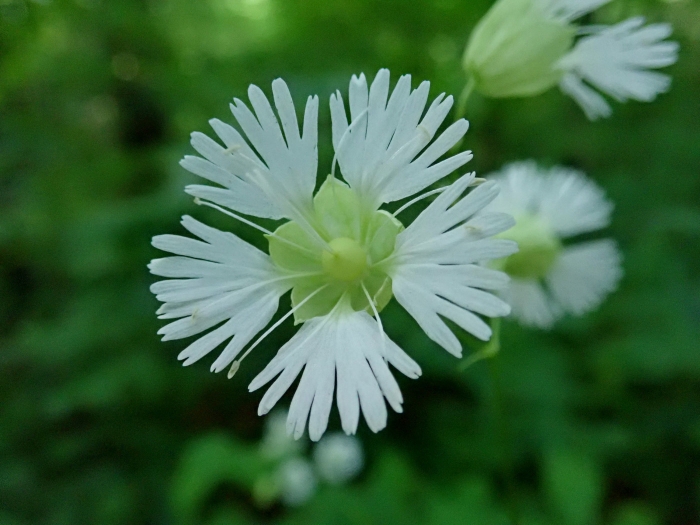Widow’s Frill
(Silene stellata)
Widow’s Frill (Silene stellata)
/
/

Evan M. Raskin
CC BY 4.0
Image By:
Evan M. Raskin
Recorded By:
Copyright:
CC BY 4.0
Copyright Notice:
Photo by: Evan M. Raskin | License Type: CC BY 4.0 | License URL: http://creativecommons.org/licenses/by/4.0/ | Rights Holder: Evan M. Raskin | Publisher: iNaturalist | Date Created: 2019-07-14T08:24:48-07:00 |

















































Estimated Native Range
Summary
Silene stellata, commonly known as Widow’s Frill, is a deciduous perennial herb native to rich, moist deciduous forests and forest edges in Eastern and Central North America. It typically grows to a height of 2-3 feet (0.6-0.9 meters) and a similar width. The plant features lanceolate leaves and clusters of star-shaped, white flowers with deeply fringed petals that bloom in the summer, providing a delicate and somewhat whimsical appearance. The flowers are especially attractive to nocturnal pollinators.
Widow’s Frill is valued for its unique frilly flowers and its ability to thrive in shaded garden spots, making it a charming addition to woodland gardens, shaded borders, and native plant gardens. It is relatively low-maintenance, requiring minimal care once established. While it prefers consistently moist soil, it can tolerate periods of drought. It is also used in restoration projects due to its adaptability to local conditions. However, it can be susceptible to root rot if drainage is poor. Gardeners should be aware that while it is not typically aggressive, it can self-seed under optimal conditions.CC BY-SA 4.0
Widow’s Frill is valued for its unique frilly flowers and its ability to thrive in shaded garden spots, making it a charming addition to woodland gardens, shaded borders, and native plant gardens. It is relatively low-maintenance, requiring minimal care once established. While it prefers consistently moist soil, it can tolerate periods of drought. It is also used in restoration projects due to its adaptability to local conditions. However, it can be susceptible to root rot if drainage is poor. Gardeners should be aware that while it is not typically aggressive, it can self-seed under optimal conditions.CC BY-SA 4.0
Plant Description
- Plant Type: Herb
- Height: 2-3 feet
- Width: 1.5-2 feet
- Growth Rate: Moderate
- Flower Color: White
- Flowering Season: Summer
- Leaf Retention: Deciduous
Growth Requirements
- Sun: Full Sun, Part Shade
- Water: Medium
- Drainage: Fast
Common Uses
Bee Garden, Bird Garden, Butterfly Garden, Drought Tolerant, Hummingbird Garden, Showy Flowers
Natural Habitat
Rich, moist deciduous forests and forest edges
Other Names
Common Names: Starry Campion, Widowsfrill
Scientific Names: , Silene stellata, Silene stellata var. scabrella, Silene stellata var. stellata, Cucubalus stellatus, Evactoma stellata, Evactoma stellata var. scabrella, Lychnis stellata subsp. scabrella, Lychnis stellata var. scabrella, Silene scabrella
GBIF Accepted Name: Silene stellata (L.) Coyte